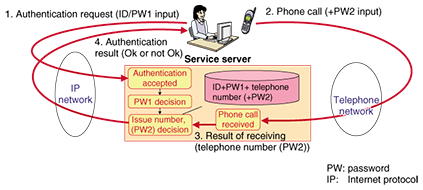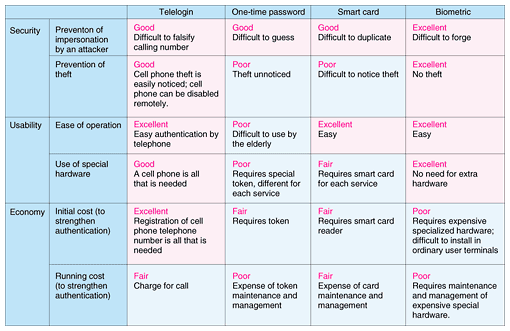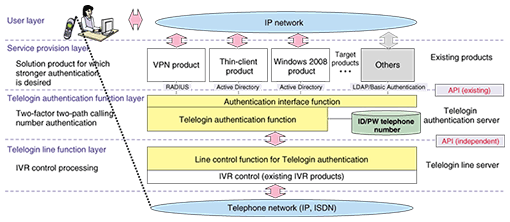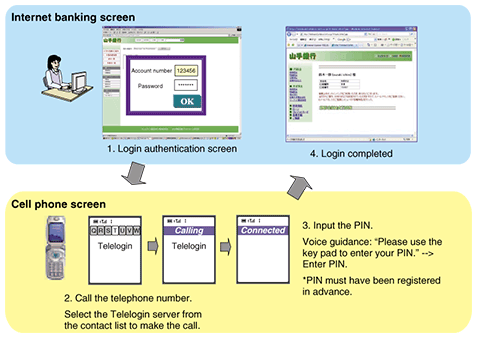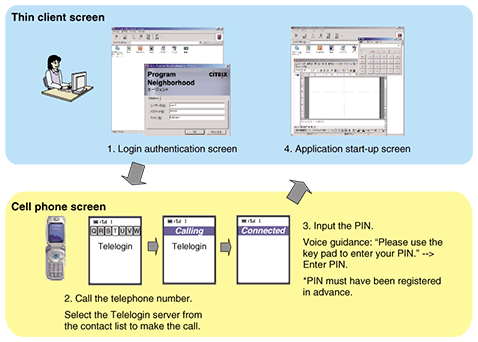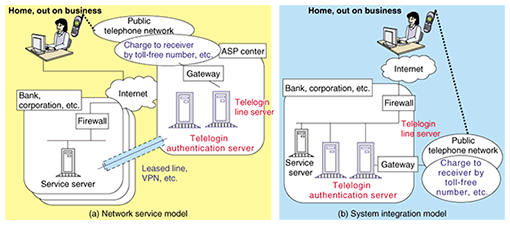 |
|||||||||||||||||||
|
|
|||||||||||||||||||
|
Letters Vol. 6, No. 8, pp. 34–39, Aug. 2008. https://doi.org/10.53829/ntr200808le3 Telelogin: a Two-factor Two-path Authentication Technique Using Caller IDAbstractThis article introduces Telelogin, a two-factor two-path authentication technique for user authentication that uses caller ID (calling number notification function) in addition to user ID and password authentication over the Internet. This technique achieves highly secure personal authentication through the simple act of making a phone call.
1. Importance of stronger personal authenticationThe Japan SOX Law established a few years ago requires banks and businesses to strengthen their internal controls and the security of network transactions. Banks are also taking measures against the problems of ID and password theft by phishing or spyware in response to directions from the Ministry of Finance for financial organizations to bolster the authentication process used for Internet banking. Two-factor authentication is emerging as the mainstream approach for strengthening the security of network transactions and Internet banking. It supplements the conventional authentication by user ID and password (information supplied from the user from memory) by adding authentication by a smart card or random number table or other thing possessed by the user or biometric authentication by, for example fingerprint or blood vein pattern recognition. However, these authentication methods have suffered from problems such as complex operation or input, requirements for special devices, and costly initial distribution and operation. Telelogin is a new two-factor authentication technique that has been attracting attention as a means of solving those problems. 2. Outline of TeleloginThe basic principle of this two-factor authentication is for the ID entered by a user from a terminal to be sent over the network and the telephone number sent from the caller's phone during a phone call (caller ID feature) to be registered with the service system. If this authentication is successful, the service is provided to that user (Fig. 1). This basic method has been patented by NTT Information Sharing Platform Laboratories.
2.1 Features of TeleloginThe special features of Telelogin are listed below.
2.2 Proof of the calling numberThe Telelogin authentication method is premised on the cell phone caller's number being genuine, and not falsified. Up to about 2005, fraudulent acts involving falsified caller ID (telephone fraud) were a problem. As measures to prevent such crimes, the Telecommunication Carriers Association formulated the Calling Number Falsification Countermeasure Guidelines in July 2005. On April 1, 2008, the Ministry of Internal Affairs and Communication put into effect the Partial Revision of the Commercial Telecommunication Facility Regulation. Following those guidelines, the various carriers implemented measures such as not forwarding the calling number for calls for which there is doubt about caller ID falsification [1]. 2.3 Comparison with other additional authentication methodsVarious additional authentication methods are compared in Table 1. Telelogin satisfies the requirements for security, convenience, and cost performance. It does involve call charges because a telephone call is made for each authentication, but the call time is only about one second per authentication. If a toll-free number service is used, there is no burden on the user.
3. Configuration of Telelogin functionsThe Telelogin authentication function is divided into an authentication function layer for processing authentication requests from various service applications and telephone function layer for simultaneously performing the processing required to receive and answer multiple telephone calls. The configuration of the Telelogin authentication functions is illustrated in Fig. 2. The telephone function layer has an interactive voice response (IVR) function for receiving and answering telephone calls. It performs voice recognition processing or voiceprint authentication processing as needed in response to the user's dialing. The authentication function layer has an interface function for Active Directory, RADIUS (remote authentication dial in user service), and other existing authentication protocols. It also manages a database for IDs, passwords, and telephone numbers and sends the authentication result to the upper service provision layer according to information from the telephone function layer.
4. Telelogin application examplesSome examples of applications are login permission for Internet banking and secondary authentication for the transfer of funds for financial organizations because they use two-factor authentication [2]. If IDs and passwords have been disclosed by phishing or eavesdropping in Internet banking, the funds in the user's account might be stolen by a malicious third party. Telelogin protects user funds by strengthening the security of authentication. The Telelogin operation for user login in Internet banking is illustrated in Fig. 3.
Another application example is login authentication in measures used to strengthen control within corporations (thin client systems, remote access gateways, etc.). Such solutions were originally designed to prevent the theft of important software or data from personal computers and other such devices used outside the company for remote access to servers and computers within the company rather than for storing software or important information in the devices used outside the company. Even with these solutions, however, there is still a risk of data leaks through the theft of IDs and passwords. The risk can be reduced by using Telelogin to strengthen authentication. The Telelogin operation for user login from a thin client is illustrated in Fig. 4.
5. Service modelsBroadly speaking, we can consider two types of Telelogin service models: the network service model (for application service providers (ASPs)) and the system integration model. The network service model provides Telelogin authentication to customers as an ASP service included in the calling charges. As shown in Fig. 5(a), a Telelogin authentication server and a Telelogin line server are placed in the ASP center and managed by the ASP. The Telelogin line server receives the customer's call via a toll-free number or other means for which the receiver bears the call charges and detects the calling number. The Telelogin authentication server uses the caller's number it receives from the Telelogin line server to perform the authentication. The thin client server or other service server that requires Telelogin authentication is installed in the customer's environment and connected to the ASP center via a line (e.g., a leased line or virtual private network (VPN)). The sharing of facilities with other customers makes the initial investment and operating cost lower. The system integration model is for customers who want to embed Telelogin authentication in their own environment. As shown in Fig. 5(b), in addition to the service server, the Telelogin authentication server, the Telelogin line server, and the telephone line that receives the Telelogin authentication telephone are all in the customer's own environment, so there is no sharing of facilities with other customers. The model can be selected according to each customer's service requirements, so a flexible response to customer needs is possible.
6. Future plansWe will proceed with the production of Telelogin products by NTT Group companies. Then, the NTT Group companies plan to expand to commercial thin-client systems and remote access gateway products such as a SSL-VPN (SSL: secure sockets layer), single sign-on products, and voiceprint authentication products. The NTT business companies also plan to provide a Telelogin authentication service for enterprises that combines a toll-free number and VPN connection as a network service. We expect the Telelogin authentication technique to continue to expand in systems of universities, where a high percentage of students have cell phones and the frequency of access from outside is high, in local government systems, which require a high degree of convenience, and in systems provided by banks, which are seeking new authentication methods. References
|
|||||||||||||||||||








